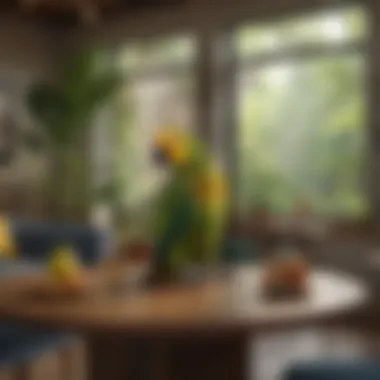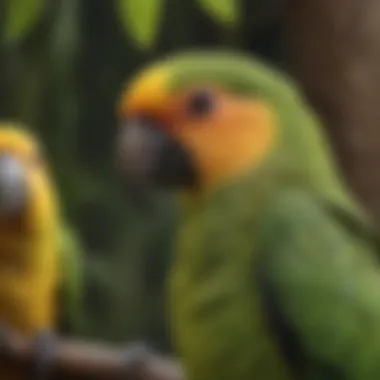Yellow-Naped Amazon Parrot Adoption Guide


Intro
The yellow-naped amazon is known for its captivating intelligence and charming personality. These birds exhibit vibrant green plumage with distinctive yellow markings, primarily around their neck. Such features contribute to their popularity among pet owners. However, adopting a yellow-naped amazon involves much more than simply appreciating their appearance. It demands an understanding of their specific care and unique needs.
In this guide, we will explore the characteristics of yellow-naped amazons, effective care practices, and the essential steps in the adoption process. Recognizing the responsibilities that come with caring for these birds allows potential adopters to make informed decisions before bringing one into their home. We will delve into grooming techniques, health and wellness insights, training methods, product recommendations, and community-driven advice, all tailored specifically for the needs of this parrot species.
By presenting detailed information and practical tips, this guide aims to equip adopters with the knowledge needed to foster a healthy, happy environment for their new companion. Let's embark on this journey to understand the yellow-naped amazon parrot and ensure a successful adoption experience.
Intro to Yellow-Naped Amazons
Yellow-naped Amazons are captivating creatures that deserve careful consideration if you are looking into avian companionship. Their appeal is not just in their striking appearance but also in their complex personalities and requirements. Understanding these aspects is crucial for prospective owners. This section aims to provide a foundational understanding of the species, which helps inform potential adopters about what to expect when integrating a Yellow-naped Amazon into their lives.
Brief Overview of the Species
Yellow-naped Amazons (Amazona auropalliata) are native to Central America. They are known for their vibrant green feathers, accented with yellow patches on the nape of their necks. This colorful appearance makes them one of the sought-after species among bird enthusiasts. They have a thriving population in the wild, but many find their way to homes through adoption. Understanding their background and natural habitat adds rich context for potential owners. This context can enhance the success of any adoption effort.
Characteristics and Behavior
These parrots exhibit a range of fascinating behaviors that highlight their intelligence. Yellow-naped Amazons are known for their vocal abilities. They can mimic sounds and speech with remarkable clarity. This characteristic leads to strong social bonds with their human companions. They thrive on interaction. Thus, potential owners must be prepared for engaging daily routines. Their playful nature can lead to various behavioral quirks, from playful antics to the need for attention. Notably, they can exhibit signs of frustration if neglected, emphasizing the responsibility that comes with their care.
Why Consider Adopting a Yellow-Naped Amazon?
Adopting a Yellow-Naped Amazon can be a rewarding experience. This species is well known for its striking appearance and dynamic personality. However, the decision to adopt should be made with care. Understanding the unique traits of these parrots is crucial for potential owners. Adopting a Yellow-Naped Amazon offers several advantages, both for the bird and the adopter.
Intelligence and Social Interaction
Yellow-Naped Amazons are particularly intelligent birds. Their cognitive abilities allow them to learn and mimic sounds with remarkable clarity. This intelligence makes them excellent companions, as they can develop a deep bond with their owners. They require mental stimulation to thrive, making social interaction vital. Engaging them through conversation, training, and play can enrich their lives significantly. They often thrive in environments where they receive enough attention and interaction.
These birds demonstrate a social nature. They are known to be affectionate and can exhibit strong preferences for their human companions. Due to their social needs, adopting a Yellow-Naped Amazon is not suitable for those who are away frequently or cannot provide adequate interaction.
"The interaction with a Yellow-Naped Amazon can enhance both the bird's and the owner's life, offering companionship and joy."
Long Lifespan and Commitment
Another significant consideration is the long lifespan of Yellow-Naped Amazons. With proper care, they can live for 40 years or more. This longevity means that potential adopters must be prepared for a long-term commitment. Owning one should not be seen as a temporary arrangement, but rather as a lifelong relationship that evolves over the years.
Before adopting, consider how this commitment fits into your lifestyle. Factors such as travel, moving, or changes in living situations can impact your ability to care for the parrot. Evaluating these elements is essential for ensuring a stable environment for the bird. Long-term responsibility includes not just the day-to-day care but also planning for potential future changes.
In summary, adopting a Yellow-Naped Amazon is about understanding their intelligence and social needs, coupled with a commitment that spans decades. It is a decision that requires careful thought and planning.
Understanding Their Needs
Understanding the specific needs of the yellow-naped amazon parrot is crucial for potential adopters. This species requires a level of care that goes beyond the basics typically provided to companion animals. By properly addressing their needs, owners can foster a healthy and nurturing environment. This can lead to a fulfilling relationship between the parrot and its human companion. Understanding their needs also prevents behavioral issues and promotes overall well-being.
Dietary Requirements
The dietary requirements of yellow-naped amazons are essential to their health. These parrots thrive on a varied diet rich in nutrients. A mix of high-quality pellets, fresh fruits, and vegetables is ideal. Specific fruits such as apples, oranges, and berries can be beneficial, while leafy greens like kale and spinach offer vital vitamins.
A complete diet should avoid excessive seeds and processed food, which can lead to obesity. Fresh water must always be available, and it should be changed daily to ensure cleanliness.
Some tips for a balanced diet include:


- Providing a variety of foods to prevent boredom.
- Introducing new foods slowly to watch for allergies.
- Ensuring proper portion sizes to maintain a healthy weight.
Housing and Environment
The housing environment profoundly impacts the well-being of yellow-naped amazons. Providing adequate space is crucial. A bigger cage allows the bird to stretch, move around, and engage in natural behaviors. A cage with horizontal bars is beneficial for climbing.
Placement is equally important. Cages should be kept in a well-lit area away from direct sunlight and drafts. Regular interaction is necessary, so the cage should be near areas where the family frequently gathers.
Creating an enriching environment is vital for mental stimulation. Consider these aspects:
- Toys: Use chewable toys, ropes, and mirrors to engage them.
- Natural Elements: Incorporate branches or perches made from safe wood varieties.
- Safe Space: Designate a safe area for them to explore outside of the cage, ensuring it is bird-proofed.
Social and Emotional Needs
Yellow-naped amazons are inherently social creatures. They require regular social interaction to thrive emotionally. Isolation can lead to behavioral issues such as screaming or plucking feathers. Engaging regularly with the bird is paramount.
Considerations for their emotional needs include:
- Daily Interaction: Spending time talking, playing, and training.
- Companionship: If possible, consider adopting two birds to fulfill their social needs.
- Routine: Establish a stable daily routine, which adds comfort and predictability to their lives.
"Understanding and meeting the needs of your yellow-naped amazon goes beyond providing food and shelter; it's about nurturing their emotional and social well-being."
By addressing dietary, environmental, and social aspects, potential adopters can set a foundation for a healthy and happy relationship with their yellow-naped amazon parrot.
The Adoption Process for Yellow-Naped Amazons
Adopting a Yellow-Naped Amazon parrot involves essential steps to ensure a successful integration into a new home. This section focuses on the adoption process, emphasizing the specific elements and considerations vital for prospective owners. Understanding this process can lead to a fulfilling relationship between the bird and its human family.
Where to Find Yellow-Naped Amazons for Adoption
Locating a Yellow-Naped Amazon for adoption requires some research. A variety of avenues exist where these parrots can be adopted.
- Animal Shelters: Local animal shelters may have parrot species within their programs.
- Rescue Organizations: Numerous organizations focus specifically on parrot rescue, such as Parrot Rescue that lists available birds for adoption.
- Online Platforms: Websites like Facebook or Reddit often have groups dedicated to bird adoptions.
- Breeders: While not all breeders focus on adoption, some may have birds needing new homes due to various circumstances.
Before proceeding, it’s essential to verify the legitimacy of the source and the well-being of the birds.
Evaluating Potential Adopters
The evaluation of potential adopters is critical in the adoption process. Organizations and shelters often conduct thorough assessments before approving an adoption.
- Home Environment: Assessing whether the home can accommodate a young bird's needs is necessary. A suitable environment ensures safety and comfort.
- Experience with Birds: Understanding an adopter’s experience with birds can determine their capability to care for a Yellow-Naped Amazon. For first-time owners, education about parrot care is crucial.
- Long-Term Commitment: Adopting a parrot involves a long-term commitment. Evaluators might inquire about the owner's willingness and ability to provide care over the bird's potentially lengthy lifespan.
- Lifestyle Considerations: A potential adopter’s lifestyle should align with the needs of a Yellow-Naped Amazon. These parrots are social, requiring time and interaction with their owners.
Evaluating these aspects helps ensure that the bird finds a suitable and nurturing home.
Home Visits and Preparations
Home visits often form an integral part of the adoption process. Organizations may conduct these visits to ensure the home meets the necessary requirements for a Yellow-Naped Amazon.
- Safety Measures: Inspecting for hazards is essential. Birds can be sensitive to toxins or dangerous objects that may pose risks.
- Cage Placement: The cage location should be in a quiet area but still within sight of the family. This provides social interaction while reducing stress.
- Necessary Supplies: New owners should prepare by acquiring a proper cage, food, toys, and perches before bringing the parrot home. This preparation helps create a cozy environment for the new pet.
- Understanding Policies: Knowing the policies of the organization helps potential adopters align their expectations.
A well-planned home visit and preparation process offers reassurance for both the organization and the prospective owner, facilitating a smoother transition for the Yellow-Naped Amazon into its new environment.
"Adopting a parrot is not just about finding a pet, rather it's about welcoming a companion that will share your life for decades."


By paying close attention to these processes, potential owners can enhance the likelihood of a successful adoption and develop a lasting bond with their new parrot.
Cost and Financial Considerations
Understanding the financial implications of adopting a Yellow-Naped Amazon parrot is crucial. This species is not only intelligent and social but also requires a commitment that goes beyond just initial adoption. Adopting a pet should be a well-thought-out decision, encompassing both one-time and recurring expenses.
Initial Adoption Fees
When planning to adopt a Yellow-Naped Amazon, potential adopters should be aware of the initial costs involved. These can include the adoption fee itself, which typically varies. Many shelters or breeders have different pricing structures based on the bird's age and health. The fees can range significantly, often from $350 to over $1,000.
Moreover, initial setup costs must also be considered. This includes purchasing a suitable cage, food dishes, toys, and other necessary supplies. A quality cage that meets the bird's needs can cost between $200 and $500. Selecting the right environment is vital to ensure the health and happiness of your new companion.
Ongoing Care Costs
Once you have brought your Yellow-Naped Amazon home, ongoing costs must be factored into your budget. These can include food, veterinary care, and supplies. A proper diet for a Yellow-Naped Amazon consists of quality pellets, fresh fruits, and vegetables. Monthly food costs can range from $30 to $50, depending on dietary choices and preferences.
Regular veterinary check-ups are also critical for the bird’s health. Budgeting for veterinary services, including routine exams, vaccinations, and potential emergencies, should not be overlooked. This can add up to several hundred dollars per year.
Other miscellaneous costs such as replacing toys, purchasing supplements, or any unforeseen health issues should also be considered. Cats and dogs often receive more attention in care discussions, but birds like the Yellow-Naped Amazon require just as much commitment.
Important Consideration: Being well-prepared financially can lead to a happier experience for both the owner and the pet. An impulsive decision or lack of foresight regarding costs may lead to unfortunate situations down the line.
In summary, adopting a Yellow-Naped Amazon comes with significant financial responsibilities. Potential adopters should comprehensively evaluate their financial readiness to ensure that they can provide the necessary care and support for their new avian friend.
Choosing the Right Environment
Creating an appropriate environment is crucial for the well-being of a yellow-naped amazon parrot. These birds thrive in settings that mimic their natural habitats, allowing them to express their behaviors and instincts. Moreover, the right environment aids in reducing stress and promoting a happy demeanor. Proper attention to specific elements, including cage selection and the overall setup of the living space, contributes significantly to their health and happiness.
Cage Selection and Placement
When selecting a cage for a yellow-naped amazon, size should be the primary consideration. The cage must be spacious enough to allow the bird to move around freely. A recommended minimum size is 36 inches in width and 24 inches in depth. This allows ample room for movement and comfort. The bars of the cage should be horizontal, enabling climbing, which is a natural behavior for these birds.
Positioning the cage is equally important. Place it in a location where the parrot can observe human activities, as these birds are highly social. Avoid placing the cage in direct sunlight or near drafts, as this can lead to health issues. Additionally, ensure the cage is elevated for a better vantage point, which is appealing for a parrot.
Creating a Stimulating Environment
Yellow-naped amazons are highly intelligent creatures that require mental and physical stimulation. A monotonous environment can result in boredom and behavioral problems. To create a stimulating space, consider adding various perches at different heights, ideally made of natural wood. Perches of varying diameters also help strengthen the bird’s feet.
Incorporating toys is essential for engagement. Rotate toys frequently to maintain interest. Use safe materials like wood or natural fibers. Include puzzle toys that encourage foraging, as it mimics their natural behavior.
Lastly, ensure access to safe climbing areas outside of the cage. Regular playtime outside the cage promotes exercise and strengthens the human-animal bond. An aviary or a designated play area can significantly enhance their environment, offering diverse experiences that contribute to their overall well-being.
Important: Always monitor your yellow-naped amazon during playtime outside the cage to ensure their safety and prevent accidents.
Training Your Yellow-Naped Amazon
Training your yellow-naped amazon is a critical aspect of responsible ownership. These birds are highly intelligent and, with structured training, can develop a strong bond with their human companions. Training goes beyond just teaching commands; it promotes a harmonious living environment, reduces undesirable behaviors, and enhances the overall well-being of the bird.
Key elements of training include establishing a consistent routine, using positive reinforcement, and understanding the unique personality of each individual bird. The benefits are profound, not only for the bird but also for the caregiver, allowing for a more fulfilling and interactive experience.
Basic Commands and Tricks
Teaching basic commands and tricks is an excellent starting point for training yellow-naped amazons. Simple actions like "step up," "come here," and "stay" can significantly improve the relationship between the owner and the bird. Training these commands can be initiated when the parrot is young, but older birds can also learn effectively, especially if approached with patience.


Here are some tips to consider:
- Use Consistent Cues: Always use the same words or signals for commands.
- Short Sessions: Limit training to 5-10 minutes to keep the bird engaged without overwhelming it.
- Positive Reinforcement: Reward desired behavior with treats or praise.
Adopting these practices helps the bird to understand what is expected and feels more secure with training scenarios.
Addressing Behavioral Issues
Behavioral issues can arise if a yellow-naped amazon is not trained properly or feels unfulfilled. Common problems may include screaming, biting, or feather plucking. Identifying the underlying issue is crucial for resolving these behaviors.
Consider the following strategies:
- Identify Triggers: Observe when and why certain behaviors occur. For instance, a bird might scream when it feels ignored.
- Provide Mental Stimulation: Engage the bird with toys and activities. A bored bird is more likely to develop bad habits.
- Seek Professional Help: If issues persist, consult an avian behaviorist or veterinarian with experience in parrot behavior.
_"Proper training is not just about commands; it sets the foundation for a trusting and loving relationship."
By understanding and addressing behavioral issues early, owners can prevent escalation and ensure a more pleasant living environment._
For more detailed information on avian care, you can visit Wikipedia or Britannica.
Training your yellow-naped amazon requires dedication, but the rewards are immeasurable. An informed and engaged owner can lead to a happy and well-adjusted pet.
Health Considerations
When contemplating the adoption of a Yellow-Naped Amazon, it is imperative to understand health considerations associated with this species. These birds are not merely companions but also active beings requiring specific attention to ensure their well-being. Focusing on health is essential not only for the bird's quality of life but also for the long-term satisfaction of the owner.
Healthy birds exhibit energy, optimal coloration, and sound vocalizations, all indicators of physical and emotional health. Addressing health matters early can prevent future complications. Regular monitoring of behaviors and physical appearance can lead to early detection of issues, which is vital in aviculture.
Common Health Concerns
Yellow-Naped Amazons, despite their vibrant personalities, are prone to certain health challenges. Understanding these common health concerns is crucial for any potential owner.
- Obesity: This can be a significant issue, often resulting from an inadequate diet and lack of physical activities. Owners should provide a balanced diet rich in fruits, vegetables, and grains while limiting seeds and fatty treats.
- Psittacine Beak and Feather Disease (PBFD): This viral disease affects feathers and beaks, leading to severe implications for well-being. Regular check-ups are essential to monitor for this disease and ensure timely intervention.
- Respiratory Issues: Poor air quality is detrimental to birds. Ensure that the environment is free from smoke, strong odors, and dust, crucial for respiratory health.
- Nutritional Deficiencies: A lack of proper nutrients can lead to serious health concerns. Ensure the diet is well-rounded to avoid deficiencies in vitamins and minerals.
Awareness of these concerns helps in making informed choices in the care provided for your pet. Communicating with a veterinarian knowledgeable about avian health can assist in navigating these issues effectively.
Regular Veterinary Care
Regular veterinary care forms the backbone of health management for a Yellow-Naped Amazon. Establishing a relationship with an avian veterinarian allows for tailored advice and preventive care.
- Routine Check-Ups: Schedule annual check-ups to monitor the bird's overall health. These visits can catch underlying health issues that may not yet present symptoms.
- Vaccinations: Discuss the necessity of vaccinations for your bird with the veterinarian. Some vaccines may be necessary depending on your location and living conditions.
- Parasite Prevention: Regular examinations can help in early detection of internal and external parasites. Preventive care is vital to avoid complications down the line.
- Beak and Nail Trimming: Regular maintenance of the beak and nails is important. This can prevent discomfort and ensure the bird can eat and move freely.
The End and Final Thoughts
Adopting a yellow-naped amazon parrot is a significant commitment that requires thorough understanding and preparation. This section is vital as it encapsulates the essence of the information discussed throughout the article. The yellow-naped amazon is not merely a pet; it is a complex creature with specific needs and high intelligence, which can result in a deep bond with its owner. However, this connection comes with responsibilities that should not be taken lightly.
Commitment to Long-Term Care
Adopting a yellow-naped amazon entails a long-term arrangement. This species can live over fifty years, which means prospective owners should be ready for a lifelong commitment. Daily care involves providing a balanced diet, social interaction, and mental stimulation. Since these birds thrive on interaction, owners need to allocate sufficient time each day to engage with them. This includes not just feeding, but also playing, training, and socializing. Also, being aware of their potential behavioral issues and proactively addressing them is crucial for a harmonious relationship.
Owners must regularly consult with avian veterinarians to ensure proper health and wellbeing. Understanding potential health concerns, such as feather plucking or obesity, and how to mitigate them is also imperative. The responsibilities of ownership go beyond the initial excitement of having a pet; they require long-term dedication and a proactive approach.
Resources for New Owners
To support new owners in this journey, various resources can enhance knowledge and preparedness. Books specializing in parrot care provide invaluable insights into behavior, training, and nutritional needs. Websites like Wikipedia and Britannica offer comprehensive articles about the species, detailing their habitat and personality traits.
Additionally, online forums and social media groups, for example, on platforms like Reddit or Facebook, allow potential and current owners to connect, share experiences, and seek advice. Consulting these resources can provide essential support during the initial stages of pet ownership.
Ultimately, the journey of adopting a yellow-naped amazon can be rewarding, but it demands informed decisions and long-term dedication. By understanding the nuances of care and utilizing available resources, prospective owners can ensure a fulfilling experience for both themselves and their feathered companions.







